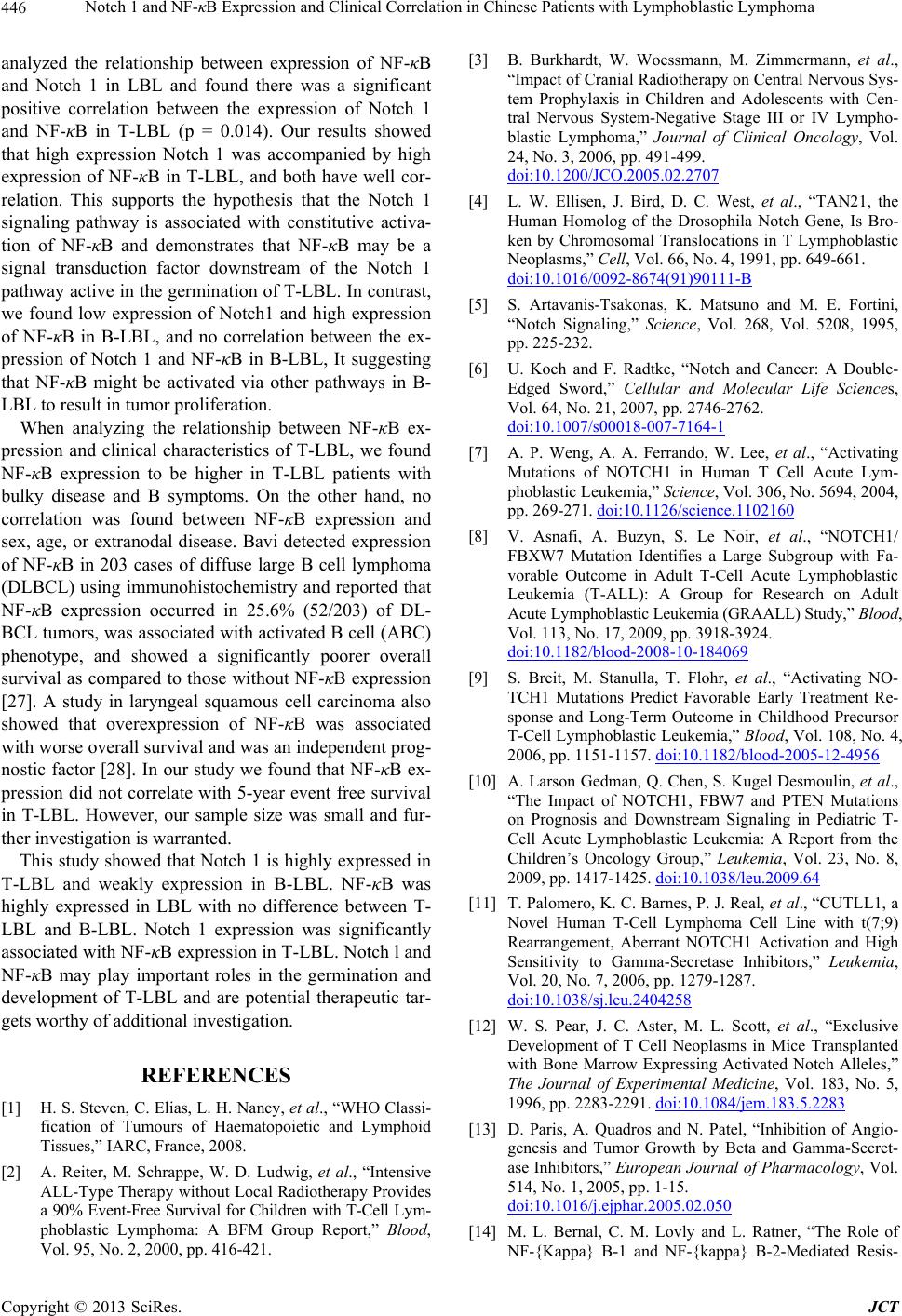
Notch 1 and NF-κB Expression and Clinical Correlation in Chinese Patients with Lymphoblastic Lymphoma
446
analyzed the relationship between expression of NF-κB
and Notch 1 in LBL and found there was a significant
positive correlation between the expression of Notch 1
and NF-κB in T-LBL (p = 0.014). Our results showed
that high expression Notch 1 was accompanied by high
expression of NF-κB in T-LBL, and both have well cor-
relation. This supports the hypothesis that the Notch 1
signaling pathway is associated with constitutive activa-
tion of NF-κB and demonstrates that NF-κB may be a
signal transduction factor downstream of the Notch 1
pathway active in the germination of T-LBL. In contrast,
we found low expression of Notch1 and high expression
of NF-κB in B-LBL, and no correlation between the ex-
pression of Notch 1 and NF-κB in B-LBL, It suggesting
that NF-κB might be activated via other pathways in B-
LBL to result in tumor proliferation.
When analyzing the relationship between NF-κB ex-
pression and clinical characteristics of T-LBL, we found
NF-κB expression to be higher in T-LBL patients with
bulky disease and B symptoms. On the other hand, no
correlation was found between NF-κB expression and
sex, age, or extranodal disease. Bavi detected expression
of NF-κB in 203 cases of diffuse large B cell lymphoma
(DLBCL) using immunohistochemistry and reported that
NF-κB expression occurred in 25.6% (52/203) of DL-
BCL tumors, was associated with activated B cell (ABC)
phenotype, and showed a significantly poorer overall
survival as compared to those without NF-κB expression
[27]. A study in laryngeal squamous cell carcinoma also
showed that overexpression of NF-κB was associated
with worse overall survival and was an independent prog-
nostic factor [28]. In our study we found that NF-κB ex-
pression did not correlate with 5-year event free survival
in T-LBL. However, our sample size was small and fur-
ther investigation is warranted.
This study showed that Notch 1 is highly expressed in
T-LBL and weakly expression in B-LBL. NF-κB was
highly expressed in LBL with no difference between T-
LBL and B-LBL. Notch 1 expression was significantly
associated with NF-κB expression in T-LBL. Notch l and
NF-κB may play important roles in the germination and
development of T-LBL and are potential therapeutic tar-
gets worthy of additional investigation.
REFERENCES
[1] H. S. Steven, C. Elias, L. H. Nancy, et al., “WHO Classi-
fication of Tumours of Haematopoietic and Lymphoid
Tissues,” IARC, France, 2008.
[2] A. Reiter, M. Schrappe, W. D. Ludwig, et al., “Intensive
ALL-Type Therapy without Local Radiotherapy Provides
a 90% Event-Free Survival for Children with T-Cell Lym-
phoblastic Lymphoma: A BFM Group Report,” Blood,
Vol. 95, No. 2, 2000, pp. 416-421.
[3] B. Burkhardt, W. Woessmann, M. Zimmermann, et al.,
“Impact of Cranial Radiotherapy on Central Nervous Sys-
tem Prophylaxis in Children and Adolescents with Cen-
tral Nervous System-Negative Stage III or IV Lympho-
blastic Lymphoma,” Journal of Clinical Oncology, Vol.
24, No. 3, 2006, pp. 491-499.
doi:10.1200/JCO.2005.02.2707
[4] L. W. Ellisen, J. Bird, D. C. West, et al., “TAN21, the
Human Homolog of the Drosophila Notch Gene, Is Bro-
ken by Chromosomal Translocations in T Lymphoblastic
Neoplasms,” Cell, Vol. 66, No. 4, 1991, pp. 649-661.
doi:10.1016/0092-8674(91)90111-B
[5] S. Artavanis-Tsakonas, K. Matsuno and M. E. Fortini,
“Notch Signaling,” Science, Vol. 268, Vol. 5208, 1995,
pp. 225-232.
[6] U. Koch and F. Radtke, “Notch and Cancer: A Double-
Edged Sword,” Cellular and Molecular Life Sciences,
Vol. 64, No. 21, 2007, pp. 2746-2762.
doi:10.1007/s00018-007-7164-1
[7] A. P. Weng, A. A. Ferrando, W. Lee, et al., “Activating
Mutations of NOTCH1 in Human T Cell Acute Lym-
phoblastic Leukemia,” Science, Vol. 306, No. 5694, 2004,
pp. 269-271. doi:10.1126/science.1102160
[8] V. Asnafi, A. Buzyn, S. Le Noir, et al., “NOTCH1/
FBXW7 Mutation Identifies a Large Subgroup with Fa-
vorable Outcome in Adult T-Cell Acute Lymphoblastic
Leukemia (T-ALL): A Group for Research on Adult
Acute Lymphoblastic Leukemia (GRAALL) Study,” Blood,
Vol. 113, No. 17, 2009, pp. 3918-3924.
doi:10.1182/blood-2008-10-184069
[9] S. Breit, M. Stanulla, T. Flohr, et al., “Activating NO-
TCH1 Mutations Predict Favorable Early Treatment Re-
sponse and Long-Term Outcome in Childhood Precursor
T-Cell Lymphoblastic Leukemia,” Blood, Vol. 108, No. 4,
2006, pp. 1151-1157. doi:10.1182/blood-2005-12-4956
[10] A. Larson Gedman, Q. Chen, S. Kugel Desmoulin, et al.,
“The Impact of NOTCH1, FBW7 and PTEN Mutations
on Prognosis and Downstream Signaling in Pediatric T-
Cell Acute Lymphoblastic Leukemia: A Report from the
Children’s Oncology Group,” Leukemia, Vol. 23, No. 8,
2009, pp. 1417-1425. doi:10.1038/leu.2009.64
[11] T. Palomero, K. C. Barnes, P. J. Real, et al., “CUTLL1, a
Novel Human T-Cell Lymphoma Cell Line with t(7;9)
Rearrangement, Aberrant NOTCH1 Activation and High
Sensitivity to Gamma-Secretase Inhibitors,” Leukemia,
Vol. 20, No. 7, 2006, pp. 1279-1287.
doi:10.1038/sj.leu.2404258
[12] W. S. Pear, J. C. Aster, M. L. Scott, et al., “Exclusive
Development of T Cell Neoplasms in Mice Transplanted
with Bone Marrow Expressing Activated Notch Alleles,”
The Journal of Experimental Medicine, Vol. 183, No. 5,
1996, pp. 2283-2291. doi:10.1084/jem.183.5.2283
[13] D. Paris, A. Quadros and N. Patel, “Inhibition of Angio-
genesis and Tumor Growth by Beta and Gamma-Secret-
ase Inhibitors,” European Journal of Pharmacology, Vol.
514, No. 1, 2005, pp. 1-15.
doi:10.1016/j.ejphar.2005.02.050
[14] M. L. Bernal, C. M. Lovly and L. Ratner, “The Role of
NF-{Kappa} B-1 and NF-{kappa} B-2-Mediated Resis-
Copyright © 2013 SciRes. JCT